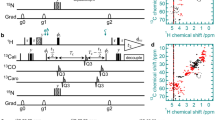Abstract
13C-2H correlation NMR spectroscopy (13C-2H COSY) permits the identification of 13C and 2H nuclei which are connected to one another by a single chemical bond via the sizeable 1JCD coupling constant. The practical development of this technique is described using a 13C-2H COSY pulse sequence which is derived from the classical 13C-1H correlation experiment. An example is given of the application of 13C-2H COSY to the study of the biogenesis of natural products from the anti-malarial plant Artemisia annua, using a doubly-labelled precursor molecule. Although the biogenesis of artemisinin, the anti-malarial principle from this species, has been extensively studied over the past twenty years there is still no consensus as to the true biosynthetic route to this important natural product – indeed, some published experimental results are directly contradictory. One possible reason for this confusion may be the ease with which some of the metabolites from A. annua undergo spontaneous autoxidation, as exemplified by our recent in vitro studies of the spontaneous autoxidation of dihydroartemisinic acid, and the application of 13C-2H COSY to this biosynthetic problem has been important in helping to mitigate against such processes. In this in vivo application of 13C-2H COSY, [15-13C2H3]-dihydroartemisinic acid (the doubly-labelled analogue of the natural product from this species which was obtained through synthesis) was fed to A. annua plants and was shown to be converted into several natural products which have been described previously, including artemisinin. It is proposed that all of these transformations occurred via a tertiary hydroperoxide intermediate, which is derived from dihyroartemisinic acid. This intermediate was observed directly in this feeding experiment by the 13C-2H COSY technique; its observation by more traditional procedures (e.g., chromatographic separation, followed by spectroscopic analysis of the purified product) would have been difficult owing to the instability of the hydroperoxide group (as had been established previously by our in vitro studies of the spontaneous autoxidation of dihydroartemisinic acid). This same hydroperoxide has been reported as the initial product of the spontaneous autoxidation of dihydroartemisinic acid in our previous in vitro studies. Its observation in this feeding experiment by the 13C-2H COSY technique, a procedure which requires the minimum of sample manipulation in order to achieve a reliable identification of metabolites (based on both 13C and 2H chemical shifts at the 15-position), provides the best possible evidence for its status as a genuine biosynthetic intermediate, rather than merely as an artifact of the experimental procedure.
Similar content being viewed by others
References
Bax A & Morris GA (1981) An improved method for heteronuc-lear chemical shift correlation by two-dimensional NMR. J. Mag. Res. 42: 501–505.
Bendall MR, Pegg DT, Weener JR & Gunther H (1984) Complete editing of 13C spectra of CDnHm groups using the UPT sequence plus gated 1H decoupling. J. Mag. Res. 59: 223–236.
Brown GD (1992) Two new compounds from Artemisia annua J. Nat. Prod. 55: 1756–1760.
Garcia-Martin ML, Garcia-Espinosa MA, Ballesteros P, Bruix M & Cerdan S (2002) Hydrogen turnover and subcellular compart-mentation of hepatic [2–13C] glutamate and [3–13C] aspartate as detected by 13C NMR. J. Biol. Chem. 277: 7799–7807.
Gunther H, Seel H & Schmickler H (1977) A new technique for the exact determination of 13C-1H spin-spin coupling constants. J. Mag. Res. 28: 145–148.
Haynes RK & Vonwiller SC (1997) From qinghao, marvelous herb of antiquity to the antimalarial trioxane qinghao-and some remarkable new chemistry. Acc. Chem. Res. 30: 73–79.
Ho KF (2000) The Biogenesis of Artemisinin (Chapter 4). M. Phil. Dissertation, The University of Hong Kong, Hong Kong.
Hoffman RE, Treitel N & Rabinovitz M (2001) 1H NMR isotope shifts arising from the substitution of 12C by 13C: application to polycyclic aromatic hydrocarbon anions. Mag. Res. Chem. 39: 489–494.
Kim NC & Kim SU (1992) Biosynthesis of artemisinin from 11,12-dihydroartemisinic acid. J. Korean Agric. Chem. Soc. 35: 106–109.
Liu JM, Ni MY, Fan YF, Tu YY, Wu ZH, Wu YL & Zhou WS (1979) Artemisinin. ActaChim. Sin. 37: 129–141.
Saunders JKM & Hunter BK (1988) Modern NMR spectroscopy. Oxford University Press, Oxford, England.
Schmitt P, Wesener JR & Gunther H (1983) 13C Spin-echo modulation through 13C, 2H spin-spin coupling: elimination of solvent signals and analysis of partially deuterated systems. J. Mag. Res. 52:511–514.
Sy LK & Brown GD (1998) Three sesquiterpenes from Artemisia annua. Phytochemistry 48: 1207–1211.
Sy LK, Haynes R & Brown GD (1998) A novel endoperoxide and related sesquiterpenes from Artemisia annua which are possibly derived from allylic hydroperoxides. Tetrahedron 54: 4345–4356.
Sy LK & Brown GD (2001) Deoxyarteannuin B, dihydro-deoxyarteannuin B and trans-5-hydroxy-2-isopropenyl-5-methylhex-3-en-1-ol from Artemisia annua. Phytochemistry 58: 1159–1166.
Sy LK, Zhu NY & Brown GD (2001) Syntheses of di-hydroartemisinic acid and dihydro-epi-deoxyarteannuin B incorporating a stable isotope label at the 15-position for studies into the biosynthesis of artemisinin. Tetrahedron 57: 8495–8510.
Sy LK & Brown GD (2002) The mechanism of the spontaneous autoxidation of dihydroartemisinic acid. Tetrahedron 58: 897–908.
Waalart TE, van Uden W, Lubberink HGM, Woerdenbag HJ, Pras N & Quak WJ (1999) Isolation and identification of dihydroartemisinic acid from Artemisia annua and its possible role in the biosynthesis of artemisinin. J. Nat. Prod. 62: 430–133.
van Zijl PCM (1987) The use of deuterium as a nucleus for locking, shimming, and measuring NMR at high magnetic fields. J Mag. Res. 75: 335–344.
Author information
Authors and Affiliations
Rights and permissions
About this article
Cite this article
Brown, G. 13C-2H correlation NMR spectroscopy studies of the in vivo transformations of natural products from Artemisia annua . Phytochemistry Reviews 2, 45–59 (2003). https://doi.org/10.1023/B:PHYT.0000004199.43295.64
Issue Date:
DOI: https://doi.org/10.1023/B:PHYT.0000004199.43295.64




